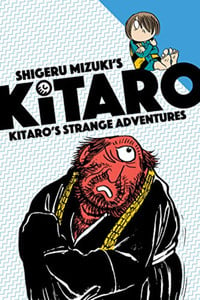Review
by Rebecca Silverman,Kitaro's Strange Adventures
GN
| Synopsis: |  |
||
In this fourth volume of Drawn & Quarterly's curated editions, Kitaro must save all of Japan's yokai from Qi, a Chinese nine-tailed fox with a grudge, defeat not one but two demons from European lore, and win happiness back from a yokai who enjoys eating it. The origin of episode two of the 2018 TV series' plot with the Miage-Nyudo is also included as Kitaro works his strange magic to save the day. |
|||
| Review: | |||
While the previous volumes of Drawn & Quarterly's new, curated release of the classic GeGeGe no Kitarō manga have arguably had themes to them, this fourth book is much more in the vein of a collection of short stories bound together only by its cast of characters. There are two stories featuring demons from European sources (unrelated to each other), but for the most part, this is just what the title promises – some oddball adventures with our favorite yokai hero. Knowing this going in helps to make the volume feel less episodic than some of the previous ones; although it doesn't have the coherency that the Tanuki Wars book does, it also makes no claim to any such thing: it's just a bunch of adventures. Of course, “just” is rarely particularly simple when it involves Kitaro, and if you've been watching the most recent incarnation of Kitaro's animated adventures, at least one of the stories in here will be of particular interest. That would be 1967's “Miage Nyudo,” which forms the basis for episode two of the 2018 TV series. This chapter is an excellent example of how things have been updated for a modern audience in the TV show but still maintain their enjoyability in the original – in 1967, Miage Nyudo takes “bad” kids and animals who poop on his sacred mountain and trains them into yokai, while in 2018, Miage Nyudo sends people to the spirit realm. Arguably, the message about declining yokai birthrates would have worked just as well today as it did in 1967, if not more so, but its message of Miage Nyudo essentially indoctrinating children to be just like him perhaps would not have sat so well. His original story is also much lighter in general – from pooping on a sacred mountain to going to “yokai school,” there's a sort of silly quality that his more modern counterpart doesn't quite have – and in the original, Kitaro is able to defeat the yokai himself instead of relying on a human helper. While we could guess that Mana was incorporated into the story in 2018 to give her a reason to exist in the series, Kitaro is also a less serious character in Mizuki's original text, so having his spirit chanchan-ko get stuck in Miage Nyudo's airpipe and cause his eyeball to explode is as much an indication of original Kitaro's unorthodox methods as it is about the joy of exploding eyeballs and taking a dump on a mountain. It's a kind of understated gross humor that falls firmly under the heading of “thrillingly disgusting” and appeals to an entirely different audience than the contemporary show is aiming for. That said, there certainly are still lessons to be learned from each of Kitaro's adventures here, besides “don't poop in people's yards.” The Miage Nyudo story has an underlying theme of respecting boundaries lest you go too far and become a monster, while the opening tale, about Qi, a Chinese yokai who is seeking to take over Japan for his people, is about being careful who (and what) you trust. That's also the message behind the Bael story, which adds in the advice that if something seems too good to be true, it very likely is. These themes and lessons are very much in keeping with folklore all over the world, and Mizuki's ability to incorporate them into his manga without sacrificing fun or making it feel like a beating from the symbolism stick is impressive. Mizuki's art remains a major attraction of the series, and you only have to look at the splash page for “Yokai Cloth” to see why. The image of Ido Senin, the Well Hermit, is a fantastical nightmare of a design, owing a lot to the Surrealism of the mid-twentieth century as much as Mizuki's own flair for the bizarre and eye for detail. It also serves as a very good representation of Mizuki's yokai as a whole – Ido Senin isn't a bad guy by any stretch of the imagination, but he's also not someone you'd want to meet walking alone at night. His design aside, the rest of the book maintains a balance between spaces so wide you can feel the emptiness and highly detailed backgrounds with the more cartoony characters standing out from them. Despite the heavier reliance of narrative text boxes and smaller, more crowded panels, the story moves along at a good clip, and reading the flow of the story is easy. If you've only been watching the show without reading the manga, this is a good volume to check out – its range of stories give a good idea of what Mizuki can accomplish while also offering interesting visuals and folkloric narratives. As always, the translation uses the original names for the characters (no Cat Chick or Wally Wall here), and the extra materials about the yokai mentioned in the stories and the history of the series itself remain fascinating. Kitaro's Strange Adventures are good, solid supernatural tales, well worth accompanying the characters on. |
| Grade: | |||
|
Overall : A-
Story : A-
Art : A
+ Wide range of stories, impressively detailed art, bonus for viewers of the 2018 anime in the Miage Nyudo story |
|||
| Production Info: | ||
|
Full encyclopedia details about Release information about |
||